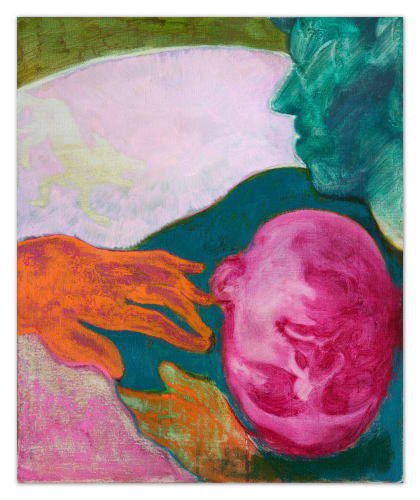VSF Seoul is pleased to announce Sebastian, Alex Foxton’s (b. 1980, England) first solo exhibition in Asia. Foxton’s elegant and boldly colored paintings have captured the attention of an international audience. Engaging with the complexity and ambiguity of masculine archetypes, Foxton mines familiar figures - soldiers, sailors, cowboys, saints, and kings - entwining them with personal narratives and an eye to the tenderness and terror that can lie beneath these images.
This body of work reflects Foxton’s long consideration of historic representations of Sebastian, an early Christian saint who famously survived being shot through with so many arrows by his fellow Roman soldiers that he looked like a sea urchin. Long a favorite subject of European painters, Sebastian is most often depicted as a beautiful, muscular, mostly nude figure, seductively tied against a post or tree, his face more ecstatic than pained, his body pricked and bleeding all over with arrows. These images reflect a common theme in both Catholic art and transgressive philosophies: That suffering can be an ecstatic path to the pleasure of redemption.
As an archetype, Sebastian has often captured the imagination of the LGBTQ community. There is a transgressive pleasure in the beauty of the figure, the panoply of penetration, and the dynamic metaphor of power and submission in the classic representations of Sebastian. At times, Foxton nudges the viewer toward these complexities with some directness, as in a work titled Sebastian (for Pier Palo [Pasolini]) or The Archer, which illustrates the virile shooting figure, also in the nude.
Foxton’s representations of Sebastian tend to eschew the characteristics of iconic works by Botticelli, Mantegna, and Bazzi (Il Sodoma) as described above. Rarely do we see him pierced by arrows, though Foxton does depict the shooters. Often his body is presented only in part or as only the head, rather than in full length contrapposto. Here Sebastian most often has his eyes closed, or his eyes are merely suggested. These works suggest a mood of absolute submission. In the works where his eyes are clear, they are open, defiant, resisting the submission often associated with martyrdom. In these small portraits, where the eyes are wide, the head is also often accompanied by one or more disembodied hands that seem like they may refer to the hands of the painter or the viewer, as they come at the throat from where we stand, implying the viewer and maker’s shared complicity in the manipulation of the figure.
The relationship between power and desire, or violence and pleasure, is often closely entwined in Foxton’s work. His paintings vibrate with tension both conceptual and formal. The images are highly seductive; bold fields of color and shimmers of metallic pigment resolve into shapes and figures. Figures interact along a knife’s edge - teetering between tenderness and violence. There is an irony in Foxton’s work, both on the formal level - painting the figure in a way that evokes Rothko - and in the humor that emerges in discovering that the images are not always what they seem. Here a pair may be engaged in bondage and seduction or torture and cruelty - the line between the two is challenging to parse and this ambiguity is electric.
Alex Foxton (b. 1980, lives and works in Paris, France) graduated with a Masters Degree from Central Saint Martins College of Art and Design, London, UK. Foxton has held solo exhibitions at Various Small Fires, Los Angeles; Kapp Kapp, New York; Galerie Derouillon, Paris and Brussels; and Air Project Art Gallery, Geneva, Switzerland. Recent group exhibitions include ICA Miami, Florida; Sprüth Magers; Galerie Perrotin, Paris; and Galerie Derouillon, Paris. His work is in the public collections at the Institute of Contemporary Art, Miami, Florida and the Santa Barbara Museum of Art, Santa Barbara, California.


